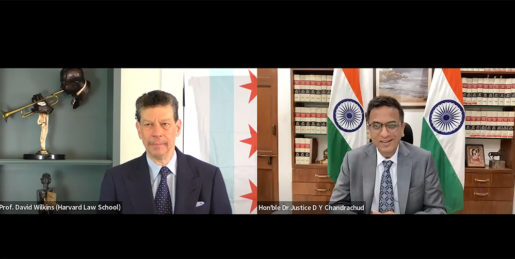A common conception of cause lawyers is that they deploy their legal acumen to safeguard underrepresented individuals or vulnerable groups against the repressive powers of the state or a general culture of apathy. In such encounters, the role of lawyers is to mediate between citizens and the state. On the other hand, lawyering for legislative reform on behalf of a politically and socially disempowered group, such as persons with disabilities, does not resort to the above conventional model. Rather, lobbying and lawyering for legislative reform on behalf of such groups provides a different view of state politics, for example, bottom-up politics and the mobilization of social movements, environmental groups, and local communities.
In their study of U.S. disability cause lawyers, Michael Ashley Stein, David Wilkins, and Michael Waterstone distinguish disability cause lawyering from the classic archetype of cause lawyering. According to them, U.S. disability cause lawyers are not “single-minded and politically naive rights crusaders” succumbing to a myth of rights and a simplistic view of the interplay between litigation and social change. In fact, disability cause lawyers view litigation as only one prong of a larger mobilization strategy; they engage in multiple forms of advocacy and seek protracted ties with the communities they serve.
Disability cause lawyering in India is neither institutionalized nor has any cohesive shape.
These disability cause lawyers aim to generate effects on the targets of litigation as well as potential allies and the public; mobilize aligned constituencies within the movement; and generate media coverage that might transform disputes and shift blame and responsibility. And like other groups, disability cause lawyers are deft in securing new rights and favorable interpretations of existing rights through legislative and regulatory processes. As pointed out by Stein, Wilkins, and Waterstone, the U.S.-based Disability Rights Bar Association originated with “a group of disability counsel, law professors, legal non-profits, and advocacy groups who shared a commitment to the effective legal representation of individuals with disabilities.” It describes itself as an online community of lawyers “who specialize in disability civil rights law” and facilitate the pursuit of stronger cases through information and strategy exchange, mentorship, and coordination efforts.
Comparatively, disability cause lawyering in India is neither institutionalized nor has any cohesive shape. It is mostly episodic with individual lawyers taking up the disability cause pro bono. Their response is often emotional and sympathetic rather than as crusaders. In India, certain disability-specific organizations, like the National Federation of the Blind, have also been instrumental, moving the Supreme Court and high courts for the cause. Certain public-spirited individuals have likewise used the mechanism of public-interest litigation to take up cudgels against the repressive and regressive attitude of the state for recognition and enforcement of the rights of persons with disability. (In particular, noted disability cause lawyers like S.K. Rungta, Jamshed Mistry, Kanchan Pamnani, and Pankaj Sinha have engaged in some important litigation.)
With its bottom-up political structure and civil rights emphasis, the U.S. state of disability cause lawyering is comparatively evolved next to India’s. In contrast, India’s disability cause lawyering is still in its nascent state, characterized by a top-down politics and predominantly influenced by constitutional law and fundamental rights. In India, the crusaders of disability rights view higher constitutional courts, such as the Apex Court of India and high courts in different states, as the main forum for the vindication of the rights of persons with disabilities. This is unlike in the United States, where lawyers typically focus on the lower courts as the bulwark for the enforcement of civil rights for Americans with disabilities.
Both the high courts and the Supreme Court of India have indulged creatively and innovatively in evolving principles, standards, and doctrines in light of India’s ratification of the Convention on the Rights of Persons with Disabilities.
Indeed, one of the striking findings of Stein et al. is the reluctance—even pessimism—among U.S.-based disability cause lawyers to bring cases to the Supreme Court. Much to the contrary, in India, the Supreme Court has led the charge of disability cause lawyering, both in substance and in spirit, starting with its 1993 decision for the National Federation of the Blind. The case pioneered disability cause lawyering in India for two reasons. First, it was argued by a blind lawyer representing the National Federation of the Blind. Second, the Court tailored the right of visually disabled persons to the constitutional conception of equality, ensuring such persons have an equal right to compete for employment in the highest echelon of public services of India. Without explicitly invoking the principle of reasonable accommodation, the Court implicitly recognized the same by allowing blind candidates to take the civil services examination with the help of a scribe. This decision came at a time when India did not have any legislative arch to capture disability. The Court also did not explicitly deploy any specific constitutional provision like the right to equality. In short, the Court implicitly—if not explicitly—recognized the capacity and ability of blind people to be worthy of occupying the positions of officers in the highest echelons of Indian administration. This litigation, which involved a collaboration between the bar and the bench, is indicative of the kind of disability cause lawyering in India.
In later cases, both the high courts and the Supreme Court of India have also indulged very creatively and innovatively in evolving principles, standards, and doctrines in light of India’s ratification of the Convention on the Rights of Persons with Disabilities (CRPD). In Vikash Kumar v. Union Public Service Commission, for example, the Supreme Court categorically held that for the enforcement of disability equality, the individualization of justice is sine qua non, and to attain equality, the state has to be cognizant of the principle of reasonable accommodation. In October 2020, in Akanksha Singh v. High Court of Delhi, the Supreme Court also refused to categorize bipolar disorder as a sign of incapacity and said that the state could not bar a person with bipolar disorder from the position of judge, upholding the decision of Delhi High Court in Bhavya Nain v. High Court of Delhi of May 2020. And, in yet another recent case, Disabled Rights Group v. Union of India, the Supreme Court recognized and enforced the principle of accessibility, directing the University Grant Commission to constitute an expert committee to prepare accessibility guidelines to be adhered to by higher educational institutions across India. By invoking the principle of intersectionality, both the Supreme Court of India and the Madras High Court recognized the vulnerability of disabled women, even emphasizing the indirect discrimination they may face.
It should be stressed that, unlike the U.S. constitution, the Indian constitution is prolix in all matters and has a very extensive bill of rights. Nevertheless, like the U.S. constitution, despite all its verbiage, the Indian constitution does not have any provision prohibiting disability-based discrimination. Although disability is one of the items mentioned in the state list, entry 8, the indifference and neutrality on the part of the 28 provinces of India in not legislating on matters pertaining to disability is striking. Indeed, the legislative arch to capture disability in India is tied to article 253 of the Indian constitution wherein the Parliament of India is obligated to legislatively incorporate the ratification of any treaty by the government of India. Both the Persons with Disabilities Act of 1995 and the Rights of Persons with Disabilities Act of 2016 are legislative incorporations of international instruments by Parliament. Hence, the Indian legal regime on disability is top-down, predominantly influenced by this international treaty obligation.
In India, the majority of disability cause lawyering is directed at enforcing the right to employment of persons with disabilities.
It should be noted that, unlike in the United States, where disability cause lawyers are often able to obtain injunctive reliefs and damages under state laws, resulting in a domino effect across states, the international nature of disability rights in India has meant a lack of interest among the provinces. Nor does the central government have any effective machinery to embed the same in the legal regime of the provinces. Though disability cause lawyers have filed suit in the high courts of most Indian states, it is not easy to bring these cases from more remote places because of huge monetary costs and the time involved. Indeed, under the Rights of Persons with Disabilities Act of 2016, every province is obligated to constitute district-wide special courts for the vindication of the rights of the disabled and also to appoint a special public prosecutor for conducting such cases. However, this provision only pertains to offenses under this particular act, thereby leaving a gap in the legal regime to engage with the violation of civil rights more generally. Viewed in this way, the legal regime pertaining to disability rights in India is horizontally thin and, with its top-down focus, has little influence on lower courts and in remote, rural pockets of the country.
Another striking distinction between disability cause lawyering in the United States and India is a lack of interest shown by U.S. disability cause lawyers in taking up employment cases for the express reason that victories, while important, redound only to individuals seeking specific remedies and do not benefit the greater community. In India, the majority of disability cause lawyering is directed at enforcing the right to employment of persons with disabilities, particularly the implementation of the quota for the disabled under section 34 of the Rights of Persons with Disabilities Act of 2016. (Indeed, the right of employment is often linked with the right to livelihood, which is recognized as a right to life and personal liberty guaranteed by article 21 of the Constitution of India.) Moreover, unlike in the United States, where there is a fair amount of Social Security benefits for unemployment, in India, affirmative action on the part of the state creates the semblance of hope among persons with disabilities to obtain jobs.
Without a cohesive and strategic movement, disability cause lawyering in India means moving the courts to seek ad hoc reliefs by way of “firefighting” rather than engaging with the causes of disability with empathy.
Against this backdrop, though disability cause lawyering is becoming more common in India, it is neither strategic nor calculated—nor is it institutional or cohesive. Since most decisions pertaining to disability rights stem from the Supreme Court and high courts, it is not easy to enforce them, and achieving compliance is an uphill task. Similarly, being constitutional courts, their decisions are predominantly declaratory and often fail to provide effective remedies in individual cases. Remedies like injunctive reliefs and compensation are very rarely granted, unlike in the United States, where there is a robust civil rights tradition and a history of compensation. Finally, in India the disability legal regime is predominantly directed at the state, thereby making it very difficult for the disabled to vindicate their claims against the private sector.
The U.S. model of disability cause lawyering will never come into play in India, not only because of different cultural, political, constitutional, and legal settings but also because of a lack of institutionalization and the allocation of appropriate funding for the evolution of a professional and strategic disability cause lawyer. Without a cohesive and strategic movement, disability cause lawyering in India means moving the courts to seek ad hoc reliefs by way of “firefighting” rather than engaging with the causes of disability with empathy.
As observed by Amita Dhanda in the “Role of Indian Judiciary in Protecting the Civil and Economic Rights of the Persons with Disabilities, “this approach means the judiciary will “provide relief in individual cases but in majority cases [will] not bring about any revolutionary change.”
Sanjay Jain is a professor at the National Law School of India University (NLSIU) in Bengaluru, India (beginning May 2022). He was previously an associate professor at Indian Law Society’s Law College, in Pune, India. He holds a Ph.D. in law from RSTM Nagpur University.



